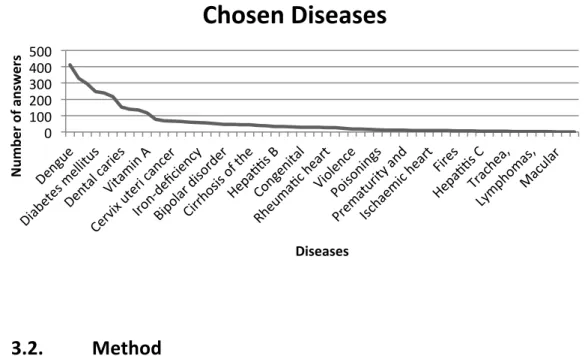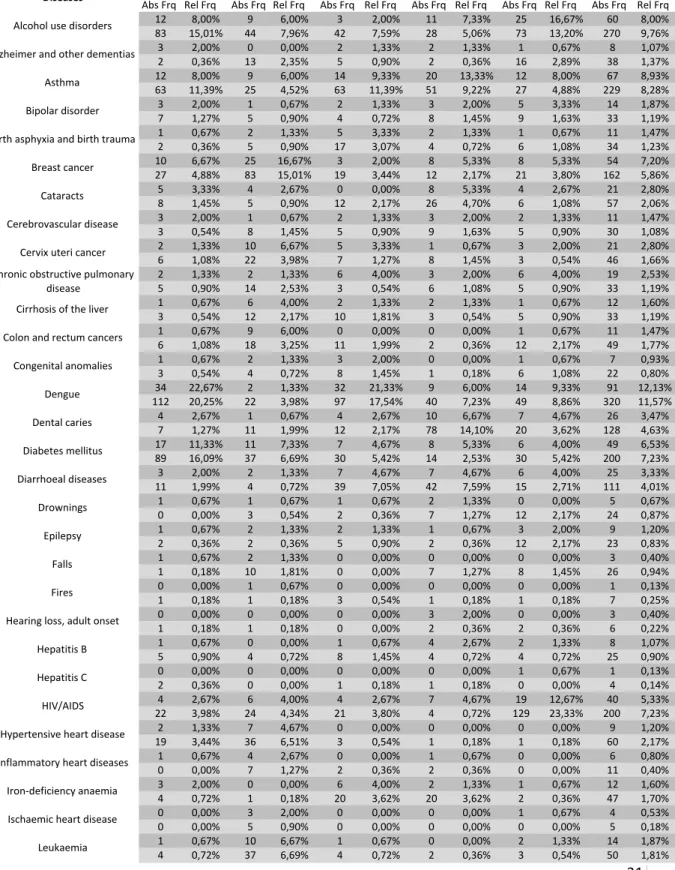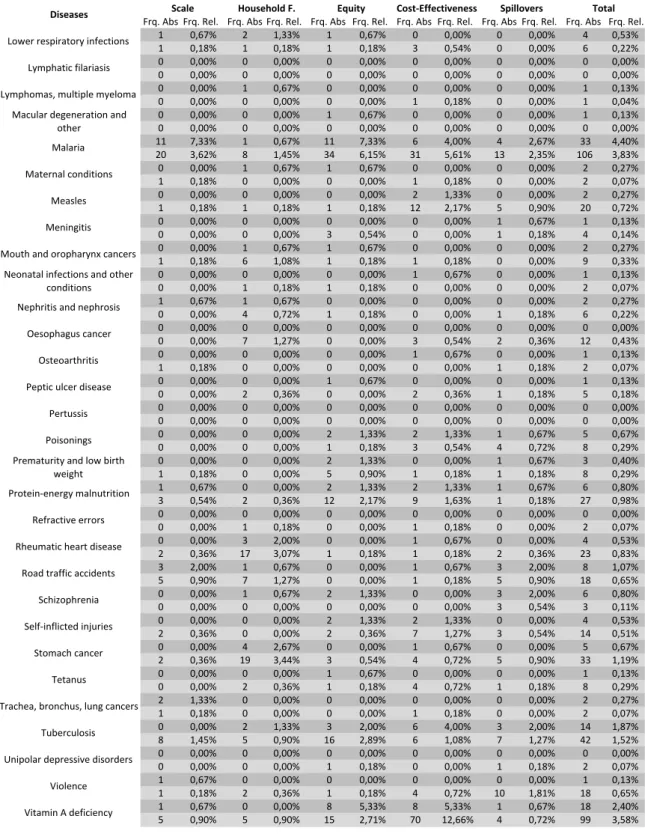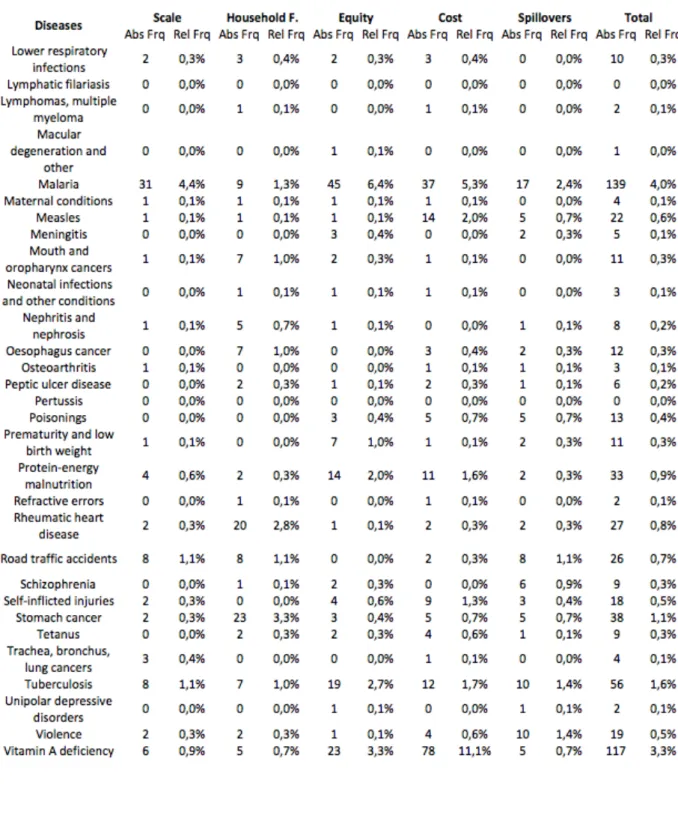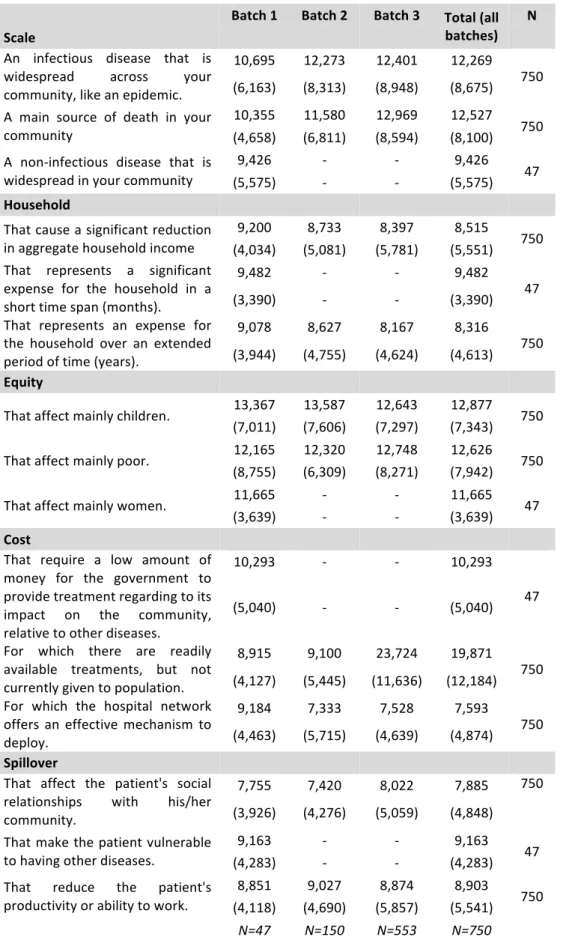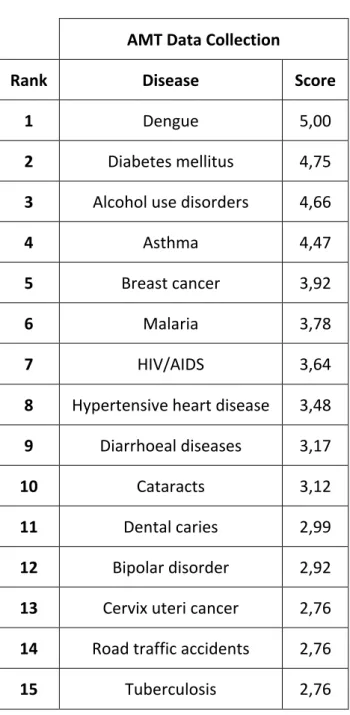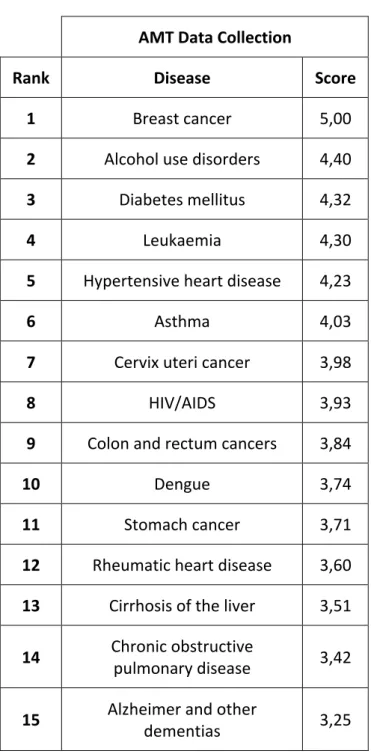Lisbon, January 2014
Project Antares and Crowdsourcing in India:
Exploring the Beneficiaries’ Perceptions of Healthcare Priorities
Candidate
Simão Pedro Vala Pires
Student ID: 152111092
Advisor
Professor Juan Andrei Villarroel Fernández, PhD
andreiv@ucp.pt
Dissertation submitted in partial fulfilment of requirements for the degree of MSc in Business Administration, at the CATÓLICA-‐LISBON School of Business and Economics,
2
Confidentiality Notice
IMPORTANT
This study benefited from privileged access to Harvard University’s Project Antares as part of the academic research collaboration between Professor Andrei Villarroel and Professor David Bloom. The contents of this work are subject to non-‐disclosure until the aforementioned parties responsible for this research agree to the release of any parts thereof. For specifics regarding this work, and for all matters pertaining to Project Antares, the reader is invited to contact the aforementioned professors leading the respective research efforts.
Acknowledgements
This work was developed in collaboration with my thesis advisor, Professor Andrei Villarroel, who challenged me to work on this research project. His mentorship and insights gave me the opportunity to learn about the topics developed in this dissertation. A special acknowledgement to Professor David Bloom, for his work on Project Antares at Harvard University School of Public Health is the basis of the research presented in this work. This research would have not been possible without the privileged access received through Professor Villarroel from Professor Bloom. Thanks also to Elizabeth Cafiero and the Project Antares team. Thanks to Professor Carlos Rondão.
I would like to thank my friends for all their support during the development of this dissertation, they were extremely important in the process. Also a special thanks to Matilde Neffe who was working on this same topic and where we collaborated in the design of the Survey as well as in its responses analysis. Additionally, during these months of work we always supported each other in order to put the best of us on both dissertations.
Last but not least, I dearly thank my parents and my brother for their support during all the months this dissertation was written, being their encouragement really
4
Abstract
Project Antares and Crowdsourcing in India:
Exploring the Beneficiaries’ Perceptions of Healthcare Priorities
The purpose of this thesis is to contribute towards an improved healthcare priority system. It is imperative that the outcomes of health prioritization tools are accurate and up-‐to-‐date. Project Antares aims to outline future informed healthcare policies and has the potential to have a great impact in a near future over the decision makers of this field. In the last decade, many companies have successfully used
crowdsourcing, act of outsourcing a task to an undefined large network to solve
some of their most challenging issues. A survey conducted on Amazon Mechanical Turk, an online crowdsourcing platform, helped us infer a set of health priorities for India. Priority scores were computed from the data collected and the results are discussed in the context of the extant literature.
Table of Contents
Acknowledgements ... 3 Abstract ... 4 1. Introduction ... 7 2. Literature Review ... 9 2.1. Crowdsourcing ... 92.2. Amazon Mechanical Turk (AMT) ... 10
2.3. Crowdsourcing in Healthcare ... 11
2.4. Project Antares ... 12
2.4.1. Antares -‐ Health Priorities Matrix ... 13
2.4.2. Antares Star -‐ Priority Profile setting ... 13
2.5. Research Hypothesis ... 15
3. Data and Method ... 15
3.1. Data ... 16 3.1.1. Priority Setting ... 17 3.1.2. Disease Priorities ... 17 3.2. Method ... 18 3.2.1. Scoring ... 19 4. Results ... 20 4.1. Priority Setting ... 20 4.2. Scoring Results ... 21
6 5. Discussion ... 23 5.1. Limitations ... 24 6. Conclusion ... 25 6.1. Practical Implications ... 26 6.2. Future Research ... 26 7. Bibliography ... 28 Appendixes ... 31
Appendix 1: Diseases Absolute and Relative Frequencies by Priority ... 31
Appendix 2: Frequencies of Survey's Priority Setting ... 35
Appendix 3: Tables comparing the Top 15 diseases in the AMT Survey ... 36
Appendix 4: AMT weighted-‐scoring comparison between Batches 2 and 3 ... 41
1. Introduction
"An ideal priority setting framework distinguishes health issues on the basis of their importance" (Bloom, 2011:3). Project Antares1, led by Professor David Bloom at Harvard University, is an integrated solution to harness the existing relation between poverty and poor health, giving a tool to develop self-‐sustaining approaches to healthcare for low-‐income populations. The Project Antares Matrix proposes an integrative solution to gather dispersed pieces of information and give a streamlined output to support healthcare priorities. Users express their preferences over what aspects of healthcare should have priority (should household finances be a priority? should cost efficiencies?). The priorities set hence translate into diseases to focus on with priority, offering a strategic decision instrument in Healthcare. Nowadays, without this tool, many health decision makers draw long-‐term strategies or define policies based on imperfect and incomplete information.
It is towards the goal of offering a systematic solution to this problem that Project Antares is integrating a diversity of data about World Wide Health conditions into a decision instrument, the Antares Matrix. Though health priorities evolve over time and the model requires up-‐to-‐date data to be reliable. This is where crowdsourcing offers a new perspective.
Even though crowdsourcing only made it to The Oxford English Dictionary in 20132, Jeff Howe coined the term in 2006, "the new poll of cheap labour (...) It's not
outsourcing; it's crowdsourcing." (Howe, 2006). This research aims to use
crowdsourced information to inform about health care priorities. Although few scientific articles lean over these topics, healthcare and crowdsourcing (e.g. Shapiro 2013), evidence of the productive use of crowdsourcing in several organizational contexts suggests that it works surprisingly well (Malone, 2010; Villarroel & Reis 2010a, 2010b; Villarroel 2008, 2013).
1 http://www.hsph.harvard.edu/antares. Last accessed on September 12, 2013.
8
We designed a survey (See: Section 3) with similar dimensions as the Antares Matrix (See: Section 2.4.1). Thus, the research question of this dissertation is the following: How can Healthcare Priorities defined by the Beneficiary Population complement those derived from Institutional Sources?
The remaining of this work starts by reviewing the existing literature on the topics of crowdsourcing, healthcare and Antares, followed by the method, results and discussion. Finally, we conclude with the practical implications of this work.
2. Literature Review
2.1.
Crowdsourcing
Crowdsourcing existed before Jeff Howe conceptualized it in 2006, he named and defined it as the "act of a company or institution taking a function once performed by employees and outsourcing it to an undefined (and generally large) network of people in the form of an open call. This can take the form of peer-‐production (when the job is performed collaboratively), but is also often undertaken by sole individuals." (Howe, 2006).
Crowd and collaborative work were previously referred by the idea of Wisdom of
Crowds, once that "under the right circumstances, groups are remarkably intelligent, and are often smarter than the smartest people in them" (Surowiecki, 2004). And he, Surowiecki (2004), continues to say that this wisdom comes from aggregating the solutions and not simply averaging them. Given that all of these terms and concepts were already here and they have implications on the R&D or problem solving process (see e.g. Lakhani & Panetta 2007; Villarroel 2008:Ch 1).
Many industries specially the ones that are very competitive on pricing were already crowdsourcing some of their design or problem solving instead of having it in-‐house, allowing them to remain competitive, so what made them noticeable again? Well, being the Web able to provide technology to gather and store millions of disparate and independent ideas (Surowiecki, 2004 & Brabham, 2008) and now boosted by the Web 2.0 that seeks to facilitate collaboration and sharing among users (Albors et al., 2008). Arguing Howe (2008) that the Internet only made it more effective.
As it became an ordinary term and topic more and more platforms to potentiate its use have appeared on the Web. So crowdsourcing platforms derive from the most different areas such as academic institutions ( ReCaptcha), start-‐ups (HumanGrid) or large multinationals (InnoCentive) (Schenk, 2009). Internet companies also get into the game with Amazon creating its own service called Amazon Mechanical Turk, which was used for this study and is the following concept addressed. Findings
10
report that people participate and "work" in these crowdsourcing online platforms, not only for the money, even if it is a small amount, but also because of the intellectual challenge, the enjoyment of the task and the strong sense of belonging (Lakhani, 2007; Villarroel 2008:Chapter 4). All of these are motivations that retain the users engaged and active online.
2.2.
Amazon Mechanical Turk (AMT)
Amazon Mechanical Turk (AMT) is a crowdsourcing web service that co-‐ordinates the supply and the demand of tasks that require human intelligence to complete (Paolacci, 2010). It started in 2005 as a service to “crowdsource” labor-‐intensive tasks, where the individuals after completing the tasks receive monetary rewards. Even though these rewards have a strong positive effect on the participation and performance of these communities, the fun of completing the work or if it helps them build their career they are willing to perform it almost for free. (Villarroel 2008:Ch 3; Villarroel and Tucci, 2009). Given the large number of individuals on the platform and due to the low compensation levels (few cents per task performed) it has been used as a pool for researchers (Villarroel 2008; Eriksson & Simpson, 2010; Paolacci, 2010).
Due to this and to the fact that the requesters, that upload the task that needs to be performed humans (called HITs, an acronym to Human Intelligence Tasks) on the platform, can reject the work that has been performed by the workers evaluating their performance makes AMT reliable for researchers (Rand, 2011). Also experiments that have a tight criterion for response also can make it through AMT once it allows segmenting the workers (for example by workers' region or reputation given previous HITs completed), while their identity is still anonymous to the requester. The ability of keeping anonymity between workers and requesters boosts the response rate (O’Neil & Penrod, 2001) turning it into an advantage while comparing with other collective platforms where their collaboration makes the anonymity extremely difficult.
This study focuses on India and AMT provides the means to reach that population. Amazon knows where is their pool of workers and a change has been reported with a greater portion of Indian subjects in recent experiments (Eriksson & Simpson, 2010). To reinforce these statements the empirical findings, from Paolacci in 2010 and Buhrmester in 2011, suggest that AMT should be considered "as a viable
alternative for data collection" (Paolacci, 2010) and "the quality of the data provided by Mechanical Turk met or exceeded the psychometric standards associated with published research" (Buhrmester, 2011). Moreover, AMT besides reducing
experiments costs also makes the recruitment easier, while reducing threats to internal validation (Paolacci, 2010).
To summarize, AMT's supportive infrastructure, subject anonymity and cultural diversity (Paolacci, 2010) make it a potentially valuable tool for health research (Shapiro, 2013).
2.3.
Crowdsourcing in Healthcare
As companies in very different industries start crowdsourcing platforms, to their use applies the same rule once "Crowdsourcing is a work process that spans across
different industries" (Bratvold, 2012). Healthcare is just one of many industries that take advantage of this concept of problem solving. The use of crowdsourcing in Healthcare led to studies in different areas of the industry, from a project to improve the physical environment of a hospital emergency department to reduce staff stress levels and increase restorative opportunities (Marshall, 2011) to the use of AMT to study clinical populations (Shapiro, 2013). This last one takes advantage from the same crowdsourcing platform that is used in this study, Amazon Mechanical Turk. Different studies relating Healthcare and Crowdsourcing are favourable to this junction. Either to improve patient and staff experience of healthcare services, a study that creates "emotion maps" based on stories told by the users to identify opportunities for service improvement (Marshall, 2011) or propose a new
12
conceptual service model to assure the reliability of healthcare information on the Internet (Park, 2013). This last on obliges systematic verification, distribution and management of healthcare information, and the management of large amounts of data requires time and financial expenditure of the government. So transferring the most important part of it, verification of healthcare information, to voluntary participation of the doctors and pharmacists through crowdsourcing, and if these specialists are the "crowd" data and tangible data is developed (Park, 2013).
As it was enumerated before on the AMT section, there are many advantages that these platforms have in comparison with the normal procedures of a research. The study conducted by Shapiro (2013) "suggests that AMT is an useful resource fro
accessing and studying clinical and subclinical populations". Relatively fast data
collection (few days to collect hundreds of answers), high quality data collection and AMT can be used to sophisticated research designs, experimental or intervention research (Shapiro, 2013).
2.4.
Project Antares
Antares is a collaboration project between the Harvard School of Public Health and Harvard Business School. Healthcare expenditures are a great part on Governments' Budgeting3 and its' decision makers face a multiplicity of challenges (Bloom, 2013), so solutions that promote an effective use of those budgets towards improved healthcare policies have to be taken in consideration. That is the role that Antares intend to have in helping "decision-‐makers organize and augment their health data
and knowledge, and to shape a coherent strategic plan" (Bloom et al, 2011).
Project Antares (PA) is under development at the time of this writing. The plan laid out by Prof. Bloom and his colleagues (Bloom et al, 2011:9) indicates that a more interactive version than the existing one will be online at some time in the future. The platform's goals are ambitious aiming to update de database on a regular basis and as ultimate goal be an anchor for Ministries of Health to set new policies, media
and political parties, or used by philanthropists to decide which disease they can have a larger impact (Bloom et al, 2011).
2.4.1. Antares -‐ Health Priorities Matrix
The key factor of Antares is its Matrix, which aggregates "available data and
research literature to deliver a ranked set of focal health areas" (Bloom et al, 2011).
Setting this ranking is giving levels of importance for each disease, being that matrix generated based on an algorithm that relates priorities sat by the user with the literature and data available on the diseases. The priorities are divided in five factors Scale of Disease, Household Financial Effects, Social Equity, Cost-‐effectiveness and Spillover Effects. Figure 1 shows the validation process for Antares to obtain their outputs.
Figure 1 -‐ Flow for Ranking's generation (Bloom et al, 2011:2)
2.4.2. Antares Star -‐ Priority Profile setting
Antares' users are able to set the priorities that are most suitable for the purpose of the ranking, either to set new healthcare policies, to promote
an informed public analysis regarding health priorities or to be a pedagogical tool for health students. Antares draws a dynamic star (Figure 2) in order to the give a better perception of the proportion of each priority in relation to the others assigning a spike to each of the following priorities:
Scale of Disease (Scale): accounts for both disease prevalence
Figure 2 -‐ Antares Priority Star (Bloom et al, 2011:9)
14
and severity, on mortality and Disability-‐Adjusted Life Years (DALY4s).
Household Financial Effects (HFE): includes both diminished household earnings due
to a given disease as well as income spent to prevent or cure the disease.
Social Equity (Equity): seeks to capture the impact of a disease on women, children,
and the poor, and more broadly, any vulnerable groups with low socio-‐economic status, as well as, their access to care.
Cost-‐Effectiveness of Available Interventions (CE): takes into account the availability
of cost-‐effective interventions to address a given disease, but also includes the possibility of innovation that would boost cost-‐effectiveness and excludes the ones that have little effective treatment, either currently or in prospect.
Spillover Effects (Spillovers): seeks to tackle two specific types of situations in which
addressing a disease has significant implications beyond the disease itself. (1) Medical spillovers that occur when one disease affects another and (2) social and economic spillovers occur when a disease has an effect on social or human capital.
4 Disability-‐Adjusted Life Years (DALY) is a measure of overall disease burden, expressed as the
2.5.
Research Hypothesis
This research focuses on testing two main hypotheses.
Each person, group or political party has different priorities regarding to healthcare. Being able to find if there is a reliable set of weighted priorities that can nearly apply to all of them, helping to purse a fixed long-‐term strategy.
H1: A Reliable Priority Setting for the Beneficiary Population can be inferred.
The Priority Setting available on Project Antares is great to come upon specific priorities depending on the part of the country, but a country most of the times should have a coordinated Healthcare Strategy and not a different on for each region. This is why an aligned priority setting nationwide should be meet, otherwise the purpose of this tool, to shape a coherent strategic plan is meaningless.
H2: The Beneficiary Population complement Institutional Sources on Healthcare
Priorities.
Crowdsourcing literature has proven that its use always brings additional information to improve upon the existing one generating a better outcome. Even though this topic, crowdsourcing, has never been addressed this way, to define healthcare priorities, it is expected to be also valid.
3. Data and Method
We designed a survey to unveil the healthcare conditions and priorities of a population through crowdsourcing. India is the focus of this study as it is the second biggest population present on Amazon Mechanical Turk (Ross, 2010). A survey administered as a HIT on AMT assessed how the Indian population rates its healthcare system and understands its priorities. Three rounds of data collection were conducted resulting in three batches of data, which altogether represent 894 responses.
16
We made sure respondents could only participate once. Answers with dubious responses were not considered (e.g. comparative assessments with 100% on one answer, and all zeroes elsewhere). Thus in the first batch 47 responses were used, 150 on the second, and 553 responses on the last one. The data used to analyse the priorities accounts 750 responses and the sample used to compute the new score of each disease 703 answers because the questions asked to infer this were only asked on the second and third batch. The following chart shows the gender distribution and the average of the age, as the sample increases the respondent profile consolidates around a 30-‐year-‐old male (Chart 1).
3.1.
Data
To assess the priorities of the respondents (colloquially referred to as “turkers” on AMT) there were asked different sets of questions to them. Firstly was done an overview of who they are by asking demographic questions. Followed by the evaluation of the Priorities, having them to assign 100 points over the sentences that described the Antares five priorities (See: Section 2.4.2). Then respondents had to identify a disease for each description of the Priorities that allowed the creation of a
29 30 31 32 0% 10% 20% 30% 40% 50% 60% 70% 80% 90% 100%
Batch 1 Batch 2 Batch 3
Ag e Percen ta ge
Batches analysis
Male Female Age
Chart 1 -‐ Batches demographic analysis
scoring dataset (See: Section 3.2.1). 3.1.1. Priority Setting
The answers collected on the population’s Priorities matches those of the Antares
star (See: Section 2.4.2). The population’s star is then computed by averaging all the
results attained (See: Table 2)
Table 2 -‐ Priority setting in each Batch and a weighted total
The numbers below each Batch correspond to a simple average of the values
obtained in the questions asked in the survey regarding each Priority. The W. Total on Table 2 above reflects a Weighted Average of all the other values, once the batches have so different number of answers their average cannot be computed straight away, as it can be seen from the mean, which is not equal to the number in the total. The value of the variance takes in considerations the three batches of data collected.
3.1.2. Disease Priorities
Each Priority assessed, was never been explicitly explained to our respondents. The way to explain each priority, so a representative disease could be assigned, was the one presented on Table 3 with those descriptions. The frequencies (absolute and relative) of diseases chosen on Batch 2 and 3 are presented on Tables 5a and 5b (See: Appendix 1). Also the compounded results of these batches are presented on Table 6a and 6b (See: Appendix 1).
Batch&1 Batch&2 Batch&3 W.&Total
N=47 N=150 N=553 N=750 Scale 20,41 24,26 24,45 24,16 23,04 5,1834 Household5F. 18,44 18,33 17,42 17,67 18,06 0,3154 Equity 24,80 24,64 24,29 24,39 24,58 0,0662 Cost 18,92 16,38 16,51 16,64 17,27 2,0470 Spillovers 17,43 16,39 17,32 17,14 17,05 0,3247 Mean&of&Batch& 1,&2&and&3 Variance Priorities
18
Table 3 -‐ Survey's Priorities descriptions
Scale Name a very widespread disease (i.e. that many people have it) that you find your community is affected by. Household
Financials
Name a disease that is costly for a household (i.e. when the household's income and expenses are severely affected by it) that you find your community is affected by.
Equity Name a disease that affects mostly vulnerable groups (i.e. poor people or children) that you find your community is affected by.
Cost-‐Effectiveness Name a disease that would cost little to treat (i.e. low-‐cost per patient) that you find your community is affected by.
Spillovers Name a disease that usually leads to social complications (i.e. stigma, marginalization, ...) that you find your community is affected by.
The compounded absolute number of answers to each disease across priorities (See: Total on Table 6a and 6b Appendix 1) is represented on Chart 2.
Chart 2 -‐ Sum of chosen diseases across priorities
3.2.
Method
Scores were generated from the data collected from AMT to build a ranking, which prioritizes the populations' expectations regarding to Healthcare.
0 100 200 300 400 500 Num be r of answe rs Diseases
Chosen Diseases
3.2.1. Scoring
We transformed the data collected into a one-‐to-‐five scoring. Chart 3 below presents that the raw frequencies used as scores disguise the differences between diseases. Being the results of the following formula a ranking of the diseases with equally distributed weight between priorities. (See: Table 4 Section 4.2).
(1) 𝑊𝑒𝑖𝑔ℎ𝑡𝑒𝑑 𝑆𝑐𝑜𝑟𝑖𝑛𝑔
= 𝐿𝑜𝑔 (1 + Σ 𝑤𝑒𝑖𝑔ℎ𝑡𝑒𝑑 % 5𝑃𝑟𝑖𝑜𝑟𝑖𝑡𝑖𝑒𝑠)
𝑀𝑎𝑥 60 𝐷𝑖𝑠𝑒𝑎𝑠𝑒𝑠 (𝐿𝑜𝑔 (1 + Σ 𝑤𝑒𝑖𝑔ℎ𝑡𝑒𝑑 % 5𝑃𝑟𝑖𝑜𝑟𝑖𝑡𝑖𝑒𝑠)) + 1 The variables used correspond to the following:
𝛴 𝑤𝑒𝑖𝑔ℎ𝑡𝑒𝑑 % 5𝑃𝑟𝑖𝑜𝑟𝑖𝑡𝑖𝑒𝑠 − It represents the sum of all the percentages of responses that each disease had in each healthcare
priority.
Max 60 Diseases − It represents the maximum value attained in the sum of the weighted percentages of the five priorities.
Chart 3 -‐ Chosen diseases and scoring
1,00 2,00 3,00 4,00 5,00 Sc or e Diseases
Chosen Diseases -‐ Scoring
20
4. Results
4.1.
Priority Setting
Recall that respondents were asked to assign 100 points between the five previously known priorities. This yielded a consistent pattern, across batches. It is noteworthy that the first batch with only 47 answers already points at Scale and Equity as a major concern (See: Table 2 Section 3.1.1). The other two (independent) batches further confirm this. Chart 4 shows the pattern of priorities of our respondent population for all three (independent) batches.
Chart 4 -‐ Priority Setting among the different batches
As it can be seen on Chart 4, Scale and Equity get so much relevance that both together almost worth 50 points of the 100 to be assigned.
Recall the sample used is the combined results from the second and third batches (N=703). We found no major differences between the data collected on these batches, and even though the survey was updated from one to another the results remained consistent (See: Appendix 4). Even though there is a difference of more than 400 respondents between batches and the results, Scores, have only minor
0,00 5,00 10,00 15,00 20,00 25,00 Scale Household F. Equity Cost Spillovers
Priority Seeng
Total Batch 1 Batch 2 Batch 3changes. The only major decrease has been on the fourth (Cost-‐Effectiveness) and fifth priority (Spillovers) with "Asthma" and "Alcohol use disorders", respectively (See: Table 10 and 11 Appendix 4)
4.2.
Scoring Results
The results presented give the complete ranking of our study on AMT, with the scores obtained by each disease. This has been achieved assigning equal weights across priorities, or 20 points (out of 100) to each.
22
Diseases Antares*
Score AMT*Score Optimal*Score
Alcohol&use&disorders 2,88 3,15 3,54 Alzheimer&and&other& dementias 2,23 1,32 1,93 Asthma 1,77 3,07 3,01 Bipolar&disorder 1,93 1,34 1,81 Birth&asphyxia&and&birth& trauma 2,92 1,32 2,28 Breast&cancer 3,03 2,52 3,12 Cataracts 2,98 1,61 2,47 Cerebrovascular& disease 3,55 1,31 2,52 Cervix&uteri&cancer 3,17 1,5 2,47 Chronic&obstructive& pulmonary&disease 2,58 1,38 2,16 Cirrhosis&of&the&liver 2,78 1,33 2,17 Colon&and&rectum& cancers 2,67 1,42 2,17 Congenital&anomalies 2,45 1,2 1,96 Dengue 1,97 3,6 3,56 Dental&caries 2,13 2,23 2,47 Diabetes&mellitus 2,95 2,63 3,22 Diarrhoeal&diseases 3,72 2,01 3,15 Drownings 1,57 1,22 1,56 Epilepsy 2,6 1,21 2 Falls 1,88 1,22 1,71 Fires 2,73 1,06 2,02 Hearing&loss,&adult& onset 1,62 1,07 1,52 Hepatitis&B 2,33 1,24 1,91 Hepatitis&C 2,07 1,03 1,65 HIV/AIDS 4,07 2,46 3,47 Hypertensive&heart& disease 3,2 1,49 2,45 Inflammatory&heart& diseases 2,3 1,14 1,83 IronOdeficiency& anaemia 2,88 1,45 2,33 Ischaemic&heart&disease 3,95 1,07 2,57
Diseases Antares*Score AMT*Score Optimal*Score
Leukaemia 2,6 1,47 2,16 Lower1respiratory1 infections 3,5 1,08 2,41 Lymphatic1filariasis 2,8 1 1,95 Lymphomas,1multiple1 myeloma 2,5 1,02 1,81 Macular1degeneration1 and1other 1,97 1,01 1,6 Malaria 2,37 2 2,48 Maternal1conditions 3,92 1,03 2,51 Measles 3,5 1,18 2,39 Meningitis 2,87 1,03 1,99 Mouth1and1oropharynx1 cancers 3,42 1,08 2,27 Neonatal1infections1and1 other1conditions 3,03 1,02 2,12 Nephritis1and1nephrosis 2,45 1,06 1,85 Oesophagus1cancer 2,83 1,1 2,03 Osteoarthritis 2,4 1,02 1,81 Peptic1ulcer1disease 2,07 1,05 1,66 Pertussis 3,5 1 2,27 Poisonings 1,83 1,1 1,6 Prematurity1and1low1 birth1weight 3,18 1,07 2,24 ProteinHenergy1 malnutrition 2,85 1,25 2,17 Refractive1errors 2,28 1,02 1,76 Rheumatic1heart1 disease 2,93 1,21 2,13 Road1traffic1accidents 2,8 1,18 2,1 Schizophrenia 2,42 1,06 1,84 SelfHinflicted1injuries 2,23 1,14 1,85 Stomach1cancer 2,97 1,29 2,2 Tetanus 3,03 1,07 2,1 Trachea,1bronchus,1lung1 cancers 3,4 1,03 2,22 Tuberculosis 3,85 1,4 2,7 Unipolar1depressive1 disorders 2,95 1,01 2,1 Violence 2,23 1,13 1,8 Vitamin1A1deficiency 2,6 1,97 2,51
5. Discussion
This research explores "How can Healthcare Priorities defined by the Beneficiary Population complement those derived from Institutional Sources?". AMT-‐derived results on healthcare priorities, and the consistency of results across batches, are a validation of this research.
(1) Survey respondents were asked to create their own priority profile, even though they were not asked directly to do it, and their answers were found to be all consistently aligned. Batch after batch the results were consistent and pointing into one direction: the important priorities to the Indian population are Scale and Equity. These results can be seen in the first batch with only 47 answers, even though the results are very inconclusive at that stage, they become more and more robust as the second batch (N=150) has the same result and finally the third one shows it clearly with the answer of 553 people (See: Table 2 Section 3.1.1). These results suggest that it is possible to infer a Profile Star for the Indian Population, offering support for H1 (H1: A Reliable Priority Setting for the Beneficiary Population can be
inferred).
These results show the importance that Indians, the second most populated country World Wide5, give to diseases that affect a lot of people (Scale) and, in a country with a lot of poverty, diseases that affect the most vulnerable ones (Equity) (See: Table 2 Section 3.1.1). These results are clear and coherent and could be considered by the decision makers: e.g. Ministers of Health if this input diverges a lot from the actual one they have. If the results are aligned with the ones they hold, then this tool allows them to reinforce their policies having more data to support those policies.
(2) The overall disease score results presented in section 4.2, and the specific scores for each priority presented in Appendix 3, offer a consistent (as discussed in (1)) and
24
complete ranking of diseases for India. This offers support for H2 (H2: The
Beneficiary Population complement Institutional Sources on Healthcare Priorities),
as the source of our data is the Beneficiary Population itself and it is completely independent from institutional sources.
Our score results adjusted to a one-‐to-‐five scale are based on the collective knowledge from a sample of the Indian population, important enough to be an added value to complete the literature. As stated before (See: Section 2.1) "under
the right circumstances, groups are remarkably intelligent" (Surowiecki, 2004), giving
support to our H2 with the gathered data. Furthermore, this wisdom comes from aggregating the solutions and not simply averaging them as it was done in this study with the formula presented on Section 3.2.
(3) Among the priorities, HIV/AIDS is the number one when people think about Spillover Effects and social stigma, making it a relevant factor for governments to take it into considerations when segmenting healthcare policies. On the other hand, regarding Household Financial Effects, Breast Cancer is on top of the list of AMT respondents. Also a special attention to Cost-‐Effectiveness that has Dental Caries scoring 5 in 5 on AMT, meaning that is cheap to treat in people's perception. In this specific case there are some treatments that are expensive, but the population finds it easier for the government to tackle it since the beginning, being able to reduce cost in the long term. Government could flag the diseases that are in this situation, managing people's expectations closing the gap between the perception and what is being done.
5.1.
Limitations
A first is, the Antares approach to priorities setting is new, so there is limited literature to categorically support, or reject, our approach, which builds on it. Another is the way the (five) priorities are defined creates limits. On Antares, as well as on AMT, each priority had a small explanation of what it meant, presuming the
user would have the necessary knowledge to understand it correctly. In a first approach (not reported in this thesis), we tried to overcome these limitations by using some drawings to explain them easily but it was not comprehensible. Given this, the easier way found to describe the priorities on AMT was through the sentences on Table 7 (See: Appendix 2).
Not least, to answer surveys on AMT people need to satisfy three requirements: have access to a computer, have Internet access, and need to be registered on AMT. The survey was able to collect hundreds of responses driven by the large number of Indians that are on that specific platform, which may not be representative of the Indian population.
6. Conclusion
Recently Healthcare treatments have been diffused over the World and are more accessible than ever. However, there are still millions of Euros that are spent in the wrong way due to miscalculations, mistakes or lack of strategic planning on this area, so Project Antares has been developing this platform to harness these issues. Given a target population, Indian citizens, AMT allowed us to reach and segment through their online platform, that in other way would have been very difficult. So there are some findings over this research that should be highlighted.
Firstly, the ability to sought data from more than 800 different people (N=894), while here in Portugal. Moreover, finding that the majority of the data was reliable and insightful for this research. Secondly, creating a star that is able to infer a portrait of the Indian Society's healthcare preferences from this sample. This conclusion comes from the fact that having 47 or 750 responses, the priorities were the same, only more robust in the last one since it has a larger sample. Concluding that people that are on AMT are replying to the surveys seriously in order to receive their payment, making it a reliable source as the literature refers.
26
6.1.
Practical Implications
All of this work developed with Antares was debuted by the following sentence:
"Global health professionals can employ the Antares methodology during strategic planning to save time, eliminate confusion, and facilitate meaningful discussion and negotiation." (Bloom, 2013:2) to this one I would add, save people and money.
Strategic planning is really important, even more in such delicate areas as healthcare, but for that the data that is being used has to be right and accurate. Everything changes at a faster pace and healthcare is not an exception, so a more recurrent interaction would have benefits.
Using real data retrieved from inhabitants would allow Antares to reflect the expectations of the population and after that may offer a more accurate ranking to the decision makers. Tackling on time a disease that is affecting hundreds of people or that affects some of the most vulnerable groups of society could help saving lives. Aligned with that a strong and well-‐founded strategy for the next years to tackle some specific diseases let the government save on their annual budget, and channel that to other areas in need.
6.2.
Future Research
Bloom et al (2011) states that research and improvements include an update to the Antares Matrix algorithm with country-‐specific data, the literature needs to be complemented with further research, a development of an interactive web-‐based version and, most important, demonstrate the use of Antares Matrix, besides finding a simpler way to update the datasets. It could also be improved by considering survey responses, as suggested in this research, or in other ways. People's input was found to be reliable and their perception of the reality, specifically related with healthcare, could allow the government to get closer to their needs and expectations.
would be almost instantaneous could give a competitive advantage to the platform. More studies are needed to understand how collective knowledge could be useful and where it adds value to this platform. Even though this study points in that direction, such improvements on the platform, since it would completely change its
28
7. Bibliography
Albors, J., Ramos, J. and Hervas, J. 2008. New learning network paradigms: Communities of objectives, crowdsourcing, wikis and open source. International
Journal of Information Management, 28 pp. 194-‐202.
Bloom, D., Cafiero, E. and Chu, M. 2013. Setting health priorities: strategy versus tactics. Psi Impact Magazine, 14.
Bloom, D., Chu, M. and Smullin, A. 2011. Antares Health Priorities Matrix -‐
Harnessing Private Enterprise for Public Health. Available online at:
http://www.hsph.harvard.edu/antares/files/2012/12/Briefing_Note_version_10.pdf. Last accessed September 12,2013.
Brabham, D. 2008. Crowdsourcing as a Model for Problem Solving. Convergence: The
International Journal of Research into New Media Technologies, 14 (1), pp. 75-‐90.
Bratvold, D. 2012. Crowdsourcing is Not an Industry, Let's Stop Calling it One. [online] Available at: http://dailycrowdsource.com/crowdsourcing/crowd-‐leaders/576-‐ crowdsourcing-‐is-‐not-‐an-‐industry-‐lets-‐stop-‐calling-‐it-‐one [Accessed: 11th March 2013].
Buhrmester, M., Kwang, T. and Gosling, S. 2011. Amazon's Mechanical Turk : A New Source of Inexpensive, Yet High-‐Quality, Data?. Perspectives on Psychological
Science, 6 (3), p. DOI: 10.1177/1745691610393980.
Eriksson, K. and Simpson, B. 2010. Emotional reactions to losing explain gender differences in entering a risky lottery. Judgment and Decision Making, 5 (3), pp. 159-‐ 163.
Howe, J. 2006. The Rise of Crowdsourcing. Wired Magazine, 14th June.
Howe, J. 2008. Crowdsourcing: Why the Power of the Crowd Is Driving the Future of
Business. Crown Business.
Lakhani, K. and Panetta, J. 2007. The Principles of Distributed Innovation. MIT
Innovations.
Malone, T., Laubacher, R. and Dellarocas, C. 2010. The Collective Intelligence Genome. MIT Sloan Management Review, 51 (3), p. 30.
Marshall, P., Cain, R. and Payne, S. 2011. Situated Crowdsourcing: a Pragmatic Approach to Encouraging Participation in Healthcare Design. 5th International
Conference on Pervasive Computing Technologies for Healthcare, DOI
10.4108/icst.pervasivehealth.2011.246095.
O’Neil, K. and Penrods, D. 2001. Methodological variables in web-‐based research that may affect results: Sample type, mon-‐ etary incentives, and personal information. Behavioral Research Methods, Instruments, & Computers, 33 (226-‐233), p. doi:10.3758/ BF03195369.
Paolaccini, G., Chandler, J. and Ipeirotis, P. 2010. Running Experiments on Amazon Mechanical Turk. Judgment and Decision Making, 5 (5), pp. XX-‐XX.
Park, S., Cho, J., Jeon, B., Kim, H. and Lee, B. 2013. Managing Healthcare Data for Improved Patient Care Using Crowdsourcing and Managed Services. International
Conferences on Intelligent Computational Systems.
Rand, D. 2011. The promise of Mechanical Turk: How online labor markets can help theorists run behavioral experiments.. Journal of Theoretical Biology, doi:10.1016/j.jtbi.2011.03.004.
Ross, J., Irani, L., Silberman, M., Zaldivar, A. and Tomlinson, B. 2010. Who are the Crowdworkers?: Shifting Demographics in Amazon Mechanical Turk. CHI EA, ((2863-‐ 2872)).
Schenk, E. and Guittard, C. 2009. Crowdsourcing: What can be Outsourced to the Crowd, and Why ?. Halshs-‐00439256, Version 1.
30
Shapiro, D., Chandler, J. and Mueller, P. 2013. Using Mechanical Turk to Study
Clinical Populations. Clinical Psychological Science, DOI:
10.1177/2167702612469015.
Surowiecki, J. 2004. The Wisdom of Crowds: Why the Many are Smarter than the Few
and How Collective Wisdom Shapes Business, Economies, Societies, and Nations..
New York: Doubleday.
Villarroel, J.A. 2008. Open Source Corporate Strategy (OSCS, aka crowdsourcing) : Unveiling the firm’s open sources of competitive advantage. Doctoral Dissertation No. 4173, EPFL, Switzerland, August 28, 2008. Available at: http://library.epfl.ch/theses/?nr=4173.
Villarroel, J.A. 2013. Strategic Crowdsourcing: The Emergence of Online Distributed Innovation. In Leading Open Innovation, edited by A. Huff, K. Moeslein, R. Reichwald. Cambridge: MIT Press.
Villarroel, J.A. and Tucci, C.L. 2009. Motivating Firm-‐Sponsored E-‐Collective Work . In Proceedings of the Academy of Management Annual Meeting, Chicago, USA, 2009. Available at SSRN: http://ssrn.com/abstract=1536209 or http://dx.doi.org/10.2139/ssrn.1536209
Villarroel, J.A., Taylor, J.E., & Tucci, C.L. 2013. Innovation and learning performance implications of free revealing and knowledge brokering in competing communities: insights from the Netflix Prize challenge. Computational and Mathematical Organization Theory, 19(1), 42-‐77. doi: 10.1007/s10588-‐012-‐9137-‐7


